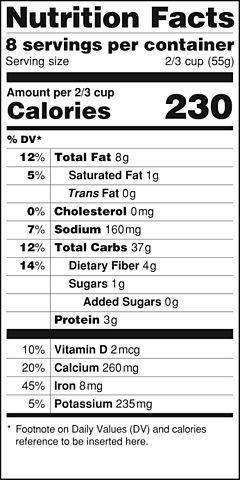How to Read Supplement Facts

How To: How to Read A Label
Reading a supplement label can be a confusing experience. Unfortunately, many companies that manufacture nutritional supplements have made it very difficult for the consumer to gather critical information about the product. There are many ways to convey information about a product, some of these ways provide accurate information in a manner that makes the product appear better than it is. In this section we will discuss some tricks to look out for as well as vital information that needs to be readily available to the consumer or health care practitioner.
Look at the serving size - This is perhaps the most common error made by consumers in picking a nutritional supplement. Each label must provide the ingredients included in a set serving. The serving size can be 1 capsule, 2 capsules, 6 capsules, etc. You can not assume that the serving size is one capsule... to the contrary, it is most commonly otherwise.
Look at the number of servings offered from one bottle. If the serving size is 6 capsules and the bottle contains 30 capsules you only have a five day supply. This may put the 50% off price tag into perspective... it would take 5 bottles for a month supply.
Look at the dose provided being sure to put it into context of the serving size. If a product contains 500 mg of an herb, but the serving size is 2 capsules then the actual per capsule dose is 250 mg.
Look for natural products. An example of this is vitamin E. The synthetic form of vitamin E, also called dl-alpha tocopherol or all-racemic alpha tocopherol, has approximately 1/3 the antioxidant activity of natural vitamin E, known as d-alpha tocopherol. Thus you will need up to three times as many capsules of a synthetic vitamin to equal one capsule of natural vitamin E.
Look at the potency
of the herb or nutritional supplement. This is perhaps one of the
most complex issues to address. In analyzing a product you often times
need a scientific understanding of the vitamin or herb in question.
Contrary to popular belief, standardization does not mean concentrating
the active ingredient. It simply means that we are concentrating an herb
to a certain level of one or more ingredients, thus assuming that all
other important constituents will also be concentrated or standardized. To
illustrate this point lets look at some examples:
- Saw Palmetto -
The usual standardization is between 85-95% fatty acids. Thus if the
product in question contains 45% Fatty acids you will need to double the
amount of herb in order to get a therapeutic dose of the product.
- Echinacea -
The traditional standardization for Echinacea is 4% Echinacosides. It
is not uncommon, however, to see products that contain no standardized
herb. It is impossible to dose this herb appropriately because one
capsule containing the raw herb may range from one to 20 capsules of the
standardized herb. Standardization allows us to dose an herb with
consistency from bottle to bottle.
- Bromelain - This enzyme is used for its anti-inflammatory activity as well as to support digestion. Generally speaking, a high quality formula will be standardized to 2400 GDU/g (Gelatin Digesting Units per Gram). It is not uncommon to see formulas with a lower potency bromelain, such as one standardized to 600 GDU/g. This would, of course, be much less potent and would require a higher dose or many more capsules to affect the same result.
Below we have listed
popular nutritional supplements and their appropriate standardizations:
Herbs:
|
Other Supplements:
i. Fish oil - Each Capsule should contain 300 mg EPA and 200 mg DHA. The product should be tested for heavy metal content such as mercury.
ii. SAMe - This product can be easily confused. SAMe is bound to to tosylate disulfate in order to stabilize the normally unstable product. Many companies will make a product that contains 200 mg of SAMe-tosylate disulfate and label it as 200 mg SAMe. This is misleading because the product contains only 100 mg SAMe. A product labeled as 200 mg of SAMe should contain 400 mg or SAMe Tosylate disulfate.
iii. Glucosamine Sulfate is another product that is easily mislabeled. In order to stabilize glucosamine sulfate you must bind it with a salt such as KCl or HCl. The ending product will weigh more than glucosamine sulfate alone. Thus you will need 2000 mg of glucosamine sulfate*KCl to get 1500 mg of glucosamine sulfate.
Click Here for Your Free Bodybuilding Magazine Subscription
Navigation
